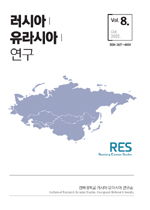학술논문
러시아 유라시아에서 문화코드로서의 ‘영화’ 연구
이용수 40
- 영문명
- A Study on ‘Film’ as a Cultural Code in Russia-Eurasia
- 발행기관
- 경북대학교 러시아-유라시아 연구소
- 저자명
- 정승원
- 간행물 정보
- 『러시아유라시아연구』제8호, 129~152쪽, 전체 24쪽
- 주제분류
- 인문학 > 기타인문학
- 파일형태
- 발행일자
- 2022.10.30
5,680원
구매일시로부터 72시간 이내에 다운로드 가능합니다.
이 학술논문 정보는 (주)교보문고와 각 발행기관 사이에 저작물 이용 계약이 체결된 것으로, 교보문고를 통해 제공되고 있습니다.

국문 초록
19세기 말에 창조된 신생 장르 영화는 상업적인 볼거리로 러시아-유라시아 지역에서도 도입되어, 하나의 문화 코드를 형성한다. 영화는 러시아-유라시아 지역에서 20세기 내내 다양한 기능과 역할을 한 문화 코드였다. 러시아 혁명 이후 소비에트 연방이 만들어지자, 소비에트 정부는 영화를 각 지역에서 교육과 선전, 계몽의 도구로 사용하였다. 20세기 초반 에이젠슈타인 등 걸출한 영화연출가들은 다양한 영화실험과 영화미학을 통해‘몽타주’등 현대영화의 기본문법들을 다지고, 걸출한 영화들을 만들어냈다. 그리고 중앙아시아 지역에서 영화는 각 민족을 하나로 통합하고 민중들을 교육하고 계몽하는 역할을 했다. 하지만, 스탈린 체제 아래 러시아-중앙아시아에서 국가의 통제와 사전 검열 하에서 영화의 기획, 제작, 배급이 이루어졌으면, 단일한 미학적 이념을 요구받았다. 스탈린 사후 맞이한‘해빙기’에 러시아 영화는 형식과 내용의 자유를 어느 정도 얻게 되고, 중앙아시아 지역에서는 영화 제작이 본격적으로 이루어진다. 페레스트로이카 이후, 러시아-유라시아 영화는 국가 권력으로부터 자유의 표현을 얻게 되지만, 다른 한편으로 자본의 압력 아래에서 시장에서의 생존을 모색하게 된다. 중앙아시아 국가들은 소연방 해체 이후 독립을 획득하지만, 일부 국가에서 영화는 다시 국가 권력의 통제에 놓이게 된다. 하지만, 1990년대에 중앙아시아 국가의 영화들은 다양한 국제영화제에서 상을 받으면서 미학적 성취를 인정받는다.
영문 초록
New genre films created at the end of the 19th century were introduced in Russia-Eurasia as a commercial attraction, forming a cultural code. Film was a cultural code that played various functions and roles throughout the 20th century in the Russian-Eurasia region. When the Soviet Union was formed after the Russian Revolution, the Soviet government used film as a tool for education, propaganda and enlightenment in each region. In the early 20th century, outstanding film directors such as Eisenstein developed the basic grammar of modern films such as 'montage' and created outstanding films through various film experiments and film aesthetics. And in Central Asia, films played a role in uniting the peoples and educating and enlightening the people. However, if a film was planned, produced, and distributed under state control and prior censorship in Russia-Central Asia under Stalin's regime, a single aesthetic ideology was required. After Stalin's death, during the 'thaw period', Russian films gained a certain degree of freedom in form and content, and film production began in earnest in Central Asia. After perestroika, Russian-Eurasia films gain expression of freedom from state power, but, on the other hand, seek survival in the market under the pressure of capital. Central Asian countries gained independence after the dissolution of the Soviet Union, but in some countries, films are again under the control of state power. However, in the 1990s, films from Central Asian countries were recognized for their aesthetic achievements, winning awards at various international film festivals.
목차
Ⅰ. 서론 - 문화 코드의 기원과 개념
Ⅱ. 문화 코드로서의 영화의 전개와 사례
Ⅲ. 결론
참고문헌
키워드
해당간행물 수록 논문
- 러시아유라시아연구 제8호 목차
- 베르댜예프 철학의 비판적 이해
- 『카라마조프가의 형제들』에서 미적 심급에 관한 소결
- Интерпретация гоголевской мистики в творчестве Булгакова
- Воздействующие речевые стратегии и тактики в медицинском дискурсе: лексические маркеры(на материале печатной рекламной продукции медицинской клиники «Сон»)
- 러시아 문화 지형에 나타난 문화코드로서의 ‘결혼’ 연구
- Современная русская поэзия: попытка классификации
- 러시아-유라시아 지역의 장례문화
- 이반 부닌의 창작 세계에 나타난 사랑과 죽음의 테마
- 러시아 철도발전 전략의 현황과 한계점
- «Путешествие по России. Санкт-Петербург»: Лингвометодическая модель обучения студентов начального и продвинутого уровней владения русским языком
- Исследование графических окказиональных трансформаций узуального слова и особенностей их использования в публицистическом дискурсе
- Буддизм в современном Горном Алтае
- Эколингвистика и проблема заимствованных слов на примере русского языка
- 러시아 유라시아에서 문화코드로서의 ‘영화’ 연구
참고문헌
관련논문
최근 이용한 논문
교보eBook 첫 방문을 환영 합니다!

신규가입 혜택 지급이 완료 되었습니다.
바로 사용 가능한 교보e캐시 1,000원 (유효기간 7일)
지금 바로 교보eBook의 다양한 콘텐츠를 이용해 보세요!





